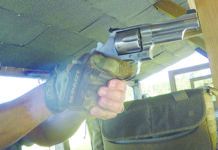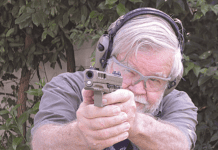Bullet-Testing Disagreements
Re Survivor Bullet Testing: .45 ACP 230-Grain Hollowpoints, October 2004:
I was greatly disappointed to see this article. It contained several glaring errors, and is far below the standards I have come to expect from your magazine.
My first problem with the article is the statement that water does an amazing job of generating the same results, vis-a-vis penetration and expansion, as 10-percent ordnance gelatin. While properly prepared and calibrated gelatin does do a good job reproducing tissue, water does not. Water, tissue, and gelatin have similar densities and will generate similar expansion results, but because water cannot support a shear force, while tissue can, water does not replicate penetration (particularly in the lower velocity ranges). The discrepancy is closer to 50 percent than 10 percent. Since Ed Sanow did not bother calibrating his gelatin studies in his book Handgun Stopping Power, any comments regarding penetration gathered from that book are suspect.
My second problem with the article regards the use of 6-inch-wide gallon containers, as the heavy plastic walls will affect the overall bullet penetration. With a margin of error of 6 inches, if you find a bullet in container No. 2, you dont know if the penetration is just over 6 inches or if the bullet would have penetrated further than 12 inches but rebounded off the container walls. A better method, which would narrow the error field, is to use half-gallon cardboard milk containers. They are thinner (4 inches), easier to penetrate, and a good rough guide to penetration can be found by multiplying the number of cartons penetrated by 2.5 (resulting penetration in inches). I refer you to Gus Coteys article, Number 1 Buckshot, the Number 1 Choice in Wound Ballistics Review, vol#2(4), 1996, for further information.
An even more accurate penetration estimate can be found in Duncan MacPhersons book, Bullet Penetration-Modeling the Dynamics and Incapacitation Resulting from Wound Trauma. MacPherson spent a great deal of time, effort, and gelatin to model the physics behind bullet penetration of dense mediums such as tissue. Charts may be found within that allow one to correlate bullet velocity and expanded diameter with a final penetration value that are reasonably accurate to actual gelatin testing.
(On a side note, MacPherson also addresses the issue of over-penetration. Skin is more resistant to penetration than other tissues, and can act as several additional inches of tissue, reducing ones fears of over-penetration.)
Third, and this is the most serious problem, while the article discusses penetration and expansion of the various calibers, there are no results for any of the bullets other than the Federal Classic round (and even then, it is not stated whether the information is for a single round or an average value). Regardless of what one may think of Ed Sanow, Gus Cotey, or Douglas MacPherson, without those values one cannot make a final judgment which brand of ammunition will suit the user. I prefer ammunition that can penetrate at least 12 inches. What can I choose? No answers are forthcoming, even though the data was apparently obtained.
I subscribe to Gun Tests to read unbiased reviews of firearms, and over the years I believe I have received just that. When your magazine rates ammunition terminal performance, however, its easy to drift towards the poor quality typical of so many gun magazines one the market today. I do hope that the inclusion of this article is not a sign of a new direction for your magazine.
-Mike Hagen
In Handgun Stopping Power, Chapter 14, Tissue Simulants, Ed Sanow shot a just-slaughtered 140-pound hog within one minute of death with a Silvertip-loaded .380 auto (this round was chosen because it was a known entity with a penetration level that would stay inside an animal of this size) in five different locations: the skull at a point where the hog skull and a human skull are roughly the same thickness, the chest through a rib and into lungs, through ribs and into the liver, the intestines, and the skin and muscle of both hind legs while avoiding the bone. Expansion and penetration were noted in all cases. Then he fired the same load, same gun, into all the common bullet-testing media (Ductseal, modeling clay, wet newspaper, water, and ordnance gelatin) and compared performance in each case to what the same bullet had done in various types of tissue. To no ones surprise, ordnance gelatin had the highest correlation with tissue. Other worthwhile information from this test was just how poorly Ductseal, wetpack and clay correlated with tissue and gelatin, and just how well water correlated with what a bullet can be expected to do in gelatin and tissue, especially lungs. It is on that chapter, and this information, the statement in our article was based.
Chapter 15, Ordnance Gelatin, details the brand, formulation, and procedures Sanow uses to prepare gelatin test blocks. The procedure of using gallon jugs for penetration tests was taught to us by Ed Sanow. The plastic used in gallon jugs is so thin and soft you can literally prick it with a pin, thus it shouldnt affect bullet performance. We use gallon jugs in large part because pre-filled water jugs can be easily purchased in any supermarket; however, it would take a dedicated milk drinker to empty enough cardboard cartons for our purposes. Switching from 6-inch to 4-inch containers would only allow us to measure bullet penetration in 2-inch increments instead of 3 inch. If you feel its worth knowing whether a bullet penetrates 10 inches instead of 9 inches, for instance, please feel free to replicate our tests using 4-inch milk cartons filled with water. Upon further review, we agree that penetration and expansion data should be provided for all the rounds, so we plan to include that information in future tests. In the 9mm article on page 22, we reformatted the tabular data to include those figures for all the rounds. -Duane Thomas
———-
No More Cowboys & Indians?
Re Short Shots, February 2005:
Ive been a happy subscriber for several years now, and have often thought of writing to thank you. The article in the February issue on how keeping boys from playing with guns is harmful has prompted me to get on the keyboard and type HURRAY!
I am a young mother with a 4-year-old, perfectly normal little boy (and a wonderful husband to boot), and from the earliest time, we bought him toy guns, soldier toys, and all the other wonderful things that little boys are supposed to play with. Im looking forward to him growing up to be a man after the pattern of his father, and who will want to someday inherit his Moms gun collection. It is amazing how difficult it is in this age of political correctness to even find a toy gun to buy for your child anymore.
I get sick of hearing the simpering of other parents decrying children playing with those war toys. I thank God every day for those brave Americans putting their lives on the line overseas and at home to protect us, who probably played with those war toys as children.
-Bess Tyner























